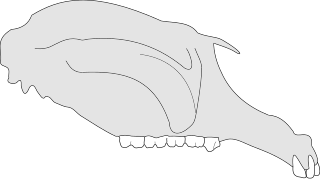
Perissodactyla is an order of ungulates. The order includes about 17 living species divided into three families: Equidae, Rhinocerotidae (rhinoceroses), and Tapiridae (tapirs). They typically have reduced the weight-bearing toes to three or one of the five original toes, though tapirs retain four toes on their front feet. The nonweight-bearing toes are either present, absent, vestigial, or positioned posteriorly. By contrast, artiodactyls bear most of their weight equally on four or two of the five toes: their third and fourth toes. Another difference between the two is that odd-toed ungulates digest plant cellulose in their intestines, rather than in one or more stomach chambers as even-toed ungulates, with the exception of Suina, do.

Tapirs are large, herbivorous mammals belonging to the family Tapiridae. They are similar in shape to a pig, with a short, prehensile nose trunk. Tapirs inhabit jungle and forest regions of South and Central America and Southeast Asia. They are one of three extant branches of Perissodactyla, alongside equines and rhinoceroses. Only a single genus, Tapirus, is currently extant. Tapirs migrated into South America during the Pleistocene epoch from North America after the formation of the Isthmus of Panama as part of the Great American Interchange. Tapirs were formerly present across North America, but became extinct in the region at the end of the Late Pleistocene, around 12,000 years ago.

The Vombatiformes are one of the three suborders of the large marsupial order Diprotodontia. Seven of the nine known families within this suborder are extinct; only the families Phascolarctidae, with the koala, and Vombatidae, with three extant species of wombat, survive.

The South American tapir, also commonly called the Brazilian tapir, the Amazonian tapir, the maned tapir, the lowland tapir, anta, and la sachavaca, is one of the four recognized species in the tapir family. It is the largest surviving native terrestrial mammal in the Amazon.

Tapirus is a genus of tapir which contains the living tapir species. The Malayan tapir is usually included in Tapirus as well, although some authorities have moved it into its own genus, Acrocodia.

The Malayan tapir, also called Asian tapir, Asiatic tapir, oriental tapir, Indian tapir, piebald tapir, or black-and-white tapir, is the only living Tapir species outside of the Americas. It is native to Southeast Asia from the Malay Peninsula to Sumatra. It has been listed as Endangered on the IUCN Red List since 2008, as the population is estimated to comprise fewer than 2,500 mature individuals.

The mountain tapir, also known as the Andean tapir or woolly tapir, is the smallest of the four widely recognized species of tapir. It is found only in certain portions of the Andean Mountain Range in northwestern South America. As such, it is the only tapir species to live outside of tropical rainforests in the wild. It is most easily distinguished from other tapirs by its thick woolly coat and white lips.

The Baird's tapir, also known as the Central American tapir, is a species of tapir native to Mexico, Central America, and northwestern South America. It is the largest of the three species of tapir native to the Americas, as well as the largest native land mammal in both Central and South America.

Pachydermata is an obsolete order of mammals described by Gottlieb Storr, Georges Cuvier, and others, at one time recognized by many systematists. Because it is polyphyletic, the order is no longer in use, but it is important in the history of systematics. Outside strict biological classification, the term "pachyderm" is commonly used to describe elephants, rhinoceroses, tapirs, and hippopotamuses.

Attalea maripa, commonly called maripa palm is a palm native to tropical South America and Trinidad and Tobago. It grows up 35 m (115 ft) tall and can have leaves or fronds 10–12 m (33–39 ft) long. This plant has a yellow edible fruit which is oblong ovoid and cream. An edible oil can be extracted from the pulp of the fruit and from the kernel of the seed.

Palaeotherium is an extinct genus of perissodactyl ungulate known from the Mid Eocene to earliest Oligocene of Europe. First described by French naturalist Georges Cuvier in 1804, Palaeotherium was among the first Paleogene mammals to be described.

Hyrachyus is an extinct genus of perissodactyl mammal that lived in Eocene Europe, North America, and Asia. Its remains have also been found in Jamaica. It is closely related to Lophiodon.

Protapirus is an extinct genus of tapir known from the Oligocene and Miocene of North America and Eurasia.

Tapirus veroensis is an extinct tapir species that lived in the area of the modern eastern and southern United States during the Pleistocene epoch (Irvingtonian-Rancholabrean). Tapirus veronensis is thought to have gone extinct around 11,000 years ago.
Colodon is an extinct genus of herbivorous mammals that were related to tapirs of today.

Nexuotapirus is an extinct genus of tapir from the Late Oligocene and Early Miocene of North America.

Propalorchestes is a fossil genus of palorchestid marsupial that existed in Australia during the Miocene epoch.
Shecenia is an extinct genus of mammal, probably belonging to the order Astrapotheria. It lived between the Late Paleocene and the Early Eocene, and its fossilized remains were found in South America.
Astrapothericulus is an extinct genus of mammals, belonging to the order Astrapotheria. It lived during the Lower Miocene in what is now South America.















